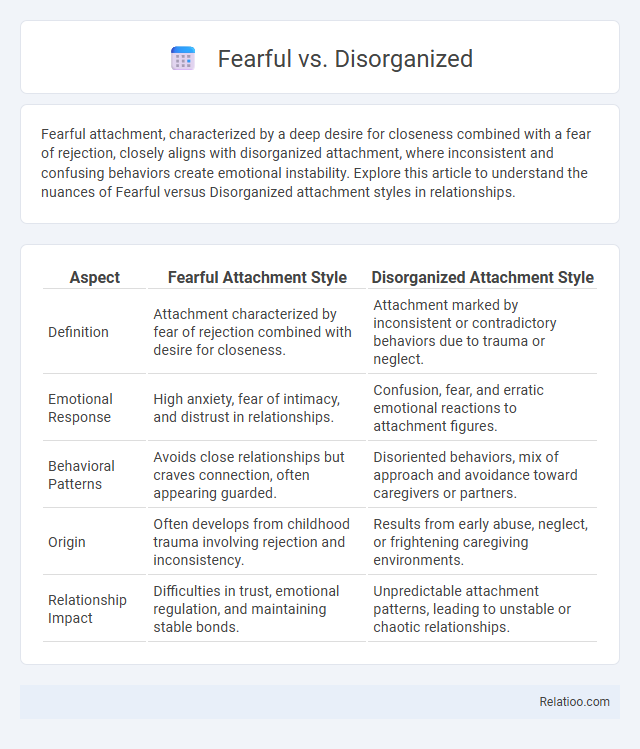Fearful attachment, characterized by a deep desire for closeness combined with a fear of rejection, closely aligns with disorganized attachment, where inconsistent and confusing behaviors create emotional instability. Explore this article to understand the nuances of Fearful versus Disorganized attachment styles in relationships.
Table of Comparison
| Aspect | Fearful Attachment Style | Disorganized Attachment Style |
|---|---|---|
| Definition | Attachment characterized by fear of rejection combined with desire for closeness. | Attachment marked by inconsistent or contradictory behaviors due to trauma or neglect. |
| Emotional Response | High anxiety, fear of intimacy, and distrust in relationships. | Confusion, fear, and erratic emotional reactions to attachment figures. |
| Behavioral Patterns | Avoids close relationships but craves connection, often appearing guarded. | Disoriented behaviors, mix of approach and avoidance toward caregivers or partners. |
| Origin | Often develops from childhood trauma involving rejection and inconsistency. | Results from early abuse, neglect, or frightening caregiving environments. |
| Relationship Impact | Difficulties in trust, emotional regulation, and maintaining stable bonds. | Unpredictable attachment patterns, leading to unstable or chaotic relationships. |
Understanding Attachment Styles: Fearful vs Disorganized
Fearful and disorganized attachment styles both stem from early relational trauma, yet fearful attachment is characterized by a deep desire for intimacy coupled with a fear of rejection, while disorganized attachment reflects a contradictory behavior pattern of seeking closeness yet exhibiting avoidance or aggression. In fearful attachment, individuals struggle with trust and self-worth, often anticipating negative outcomes in relationships, whereas disorganized attachment manifests as confusion and unpredictability in emotional responses, frequently linked to unresolved trauma or neglect. Recognizing these distinctions aids in targeted therapeutic approaches, enhancing emotional regulation and fostering healthier interpersonal connections.
Key Characteristics of Fearful Attachment
Fearful attachment is characterized by a deep fear of rejection and mistrust in relationships, leading to ambivalence between seeking closeness and avoiding intimacy. Unlike disorganized attachment, which combines anxiety and avoidance often stemming from trauma or neglect, fearful attachment specifically involves an intense desire for connection hindered by fear of getting hurt. Your understanding of these key characteristics can help in recognizing patterns that affect emotional bonds and support personal growth.
Defining Disorganized Attachment Patterns
Disorganized attachment patterns combine elements of both fearful and anxious attachments, presenting as a lack of coherent coping strategy in relationships due to conflicting desires for closeness and fear of rejection. Your behaviors may simultaneously seek intimacy while avoiding it, reflecting deep confusion and emotional turmoil often rooted in trauma or inconsistent caregiving. Understanding disorganized attachment helps in recognizing how your emotional responses are shaped by these contradictory patterns, informing healthier relational strategies.
Core Differences Between Fearful and Disorganized Attachments
Fearful attachment is characterized by a desire for closeness combined with a fear of rejection, leading to anxiety and avoidance in relationships. Disorganized attachment typically arises from trauma or inconsistent caregiving, resulting in confused and unpredictable behavior toward attachment figures. Your understanding of these core differences helps in identifying whether fear stems from internal conflict or external relational chaos.
Root Causes of Fearful Attachment
Fearful attachment stems primarily from early experiences of trauma, neglect, or inconsistent caregiving, leading to a deep mistrust in relationships and fear of abandonment. Unlike disorganized attachment, which is marked by chaotic and contradictory behaviors due to unresolved trauma, fearful attachment involves a blend of desire for closeness and avoidance rooted in anxiety. Understanding the root causes of your fearful attachment can help in developing healthier relational patterns and emotional resilience.
Origins of Disorganized Attachment in Early Childhood
Disorganized attachment originates from inconsistent or frightening caregiving in early childhood, where a child's primary caregiver may display both comfort and threat, causing confusion and fear in the child. You may experience disorganized attachment if your early environment disrupted your ability to develop a predictable sense of safety and trust. Unlike fearful or simply anxious attachments, disorganized attachment specifically arises from trauma or neglect that fractures the child's emotional regulation and attachment system.
Emotional Responses in Fearful vs Disorganized Individuals
Fearful individuals exhibit emotional responses characterized by heightened anxiety and avoidance due to anticipation of rejection or harm, often resulting in withdrawal and hypervigilance. Disorganized individuals display fragmented emotional responses marked by confusion, fear, and contradictory behaviors, stemming from unresolved trauma or attachment disruptions. The disorganized emotional pattern includes unpredictable shifts between approach and avoidance, making regulation and coping more challenging compared to the consistent avoidance seen in fearful attachment.
Impact on Relationships: Fearful vs Disorganized Attachment
Fearful attachment leads to avoidance of intimacy due to fear of rejection, causing difficulties in forming stable relationships and emotional closeness. Disorganized attachment results in unpredictable behavior, as individuals struggle to reconcile their need for closeness with fear of abandonment, often creating confusion and instability in relationships. Both attachment styles impair trust and communication, but disorganized attachment is marked by greater behavioral inconsistency and emotional turmoil.
Healing and Recovery Strategies for Each Attachment Style
Healing strategies for Fearful attachment focus on building trust through consistent, compassionate relationships and practicing emotional regulation to reduce anxiety. Disorganized attachment requires therapy that addresses trauma, such as EMDR or trauma-informed cognitive behavioral therapy, to integrate conflicting emotions and create safe relational patterns. Your recovery from either style benefits from mindfulness practices, secure attachment modeling, and gradual exposure to vulnerability within supportive environments.
Building Secure Attachment: Overcoming Fearful and Disorganized Patterns
Building secure attachment requires understanding the distinctions between fearful, disorganized, and fearful-avoidant patterns, which often stem from inconsistent caregiving and unresolved trauma. Therapeutic interventions such as trauma-informed therapy, mindfulness practices, and emotional regulation techniques foster safety and trust, enabling individuals to rewrite maladaptive attachment scripts. Consistent support and relational repair promote the development of secure attachment, marked by emotional resilience and healthier interpersonal connections.

Infographic: Fearful vs Disorganized
 relatioo.com
relatioo.com